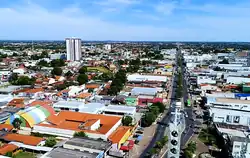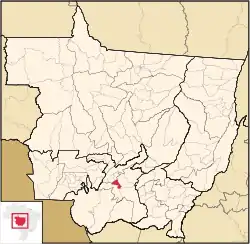Várzea Grande | |
|---|---|
Municipality | |
 view of Várzea Grande | |
 Flag  Seal | |
 Within Mato Grosso | |
 Várzea Grande Location in Brazil | |
| Coordinates: 15°38′49″S 56°07′58″W / 15.64694°S 56.13278°W | |
| Country | |
| Region | Center-West |
| State | Mato Grosso |
| Mesoregion | Centro-Sul Mato-Grossense |
| Government | |
| • Mayor | Lucimar Sacre de Campos (Democrats) |
| • Demonym | varzeagrandense |
| Area | |
| • Total | 938.057 km2 (362.186 sq mi) |
| Elevation | 198 m (650 ft) |
| Population (2020 [1]) | |
| • Total | 287,526 |
| • Density | 310/km2 (790/sq mi) |
| Time zone | UTC -4 |
Várzea Grande is a municipality in the state of Mato Grosso in the Central-West Region of Brazil.[2][3][4][5]
History
The "City of the Great Lowlands" arose from a donation of land grants given to the Guaná people in 1832, considered civilized by the Portuguese and known for their skills as boatmen and fishermen, by the imperial government. The city, whose name roughly translates into English as "Great Lowlands of the Guana", was a mandatory stop along the way for the herds of cattle that came from Upper Rio Rosario (now Rosario West ) that were en route to Cuiabá.
Its foundation is closely linked to the military camp - Camp Couto Magalhães - built during the Paraguayan War, near the current center of town. However, this military camp, which gave support to the state capital during the war, which was established on May 15, 1867, by general, lawyer, and diamond mining town founder, José Vieira Couto de Magalhães, was located on the left shore of the Cuiabá River, or on the other side of the river from the city of Cuiabá, near the mouth of the Rio Coxipó, the northern capital.
Economy
Várzea Grande is predominantly commercial and industrial, and subsistence agriculture. Through tax incentives and land grants, industries settled in the region, constituting, together with the capital, the main industrial center of the state.
Geography
Várzea Grande bordering the municipalities of Cuiabá, Santo Antônio de Leverger, Our Lady of Deliverance, Acorizal and Raft. The city formerly belonged to the municipality of Cuiabá, but was later separated; with the Cuiabá River forming the boundary between the two municipalities.
The savanna dominates the region with the densest forest on riversides and wetlands are already seeing a trend of transition to the Pantanal. Varzea Grande is located more than 180m sea level.
Climate
Várzea Grande and Cuiabá have a tropical hot and humid climate. The temperature range varies from 17 °C to 32 °C in winter, in recent times has been very strict temperature lowered to 10 °C in July with windchill 4.9 °C. The summer is very hot with temperatures ranging from 23 C to 40 °C. Várzea Grande and Cuiabá have hot nights with temperatures that can reach 32 °C, and drop to around 24 °C.
Demographics
According to data from demographic census carried out by IBGE in 2010, the population of Várzea Grande is concentrated almost entirely in the urban area. Nothing more than 248,829 people - 98.46% of the total population - live in urban areas, with only 3880 inhabitants (1.54%) in rural areas.
Most of the population of 252,709 inhabitants are women, 127,351 are women (50.39%) against 125,358 men (49.61%).
As its population recorded in 2000 was 215,298 inhabitants, Várzea Grande grew 17.37% in ten years - or 1.73% per year - with an absolute growth of 37,411 people in that period.
Transportation
Public transportation is done by buses, collective taxis and motorcycle taxi, integrated with Cuiabá.
According to the Traffic Department of the MT, the fleet of Cuiabá and Várzea Grande consists of a total of 292,219 vehicles (215,174 and 77,045 respectively), while 152,366 are cars (117,310 and 35,056 respectively) are 77,024 motorcycles / scooters (51,699 and 25,325 respectively ) (RENAEST est. 2008).
Marechal Rondon International Airport, which also serves Cuiabá is located at Várzea Grande.
Infrastructure
Education
- Centro Universitário de Várzea Grande
See also
References
- ↑ IBGE 2020
- ↑ "Divisão Territorial do Brasil" (in Portuguese). Divisão Territorial do Brasil e Limites Territoriais, Instituto Brasileiro de Geografia e Estatística (IBGE). July 1, 2008. Retrieved December 17, 2009.
- ↑ "Estimativas da população para 1º de julho de 2009" (PDF) (in Portuguese). Estimativas de População, Instituto Brasileiro de Geografia e Estatística (IBGE). August 14, 2009. Retrieved December 17, 2009.
- ↑ "Ranking decrescente do IDH-M dos municípios do Brasil" (in Portuguese). Atlas do Desenvolvimento Humano, Programa das Nações Unidas para o Desenvolvimento (PNUD). 2000. Retrieved December 17, 2009.
- ↑ "Produto Interno Bruto dos Municípios 2002–2005" (PDF) (in Portuguese). Instituto Brasileiro de Geografia e Estatística (IBGE). December 19, 2007. Archived from the original (PDF) on October 2, 2008. Retrieved December 17, 2009.
External links
 Várzea Grande travel guide from Wikivoyage
Várzea Grande travel guide from Wikivoyage
